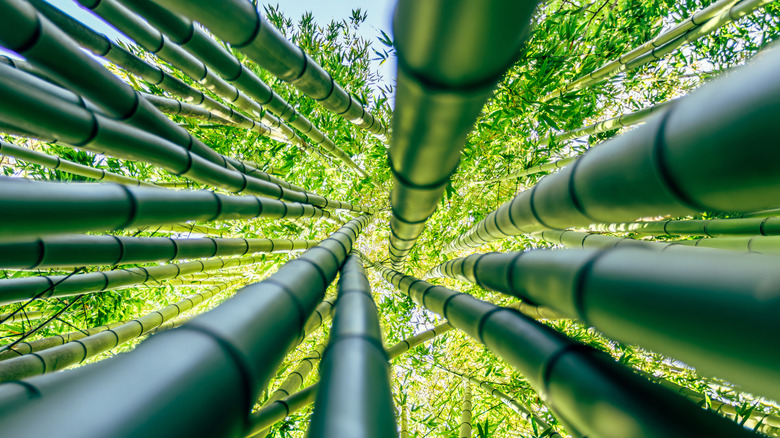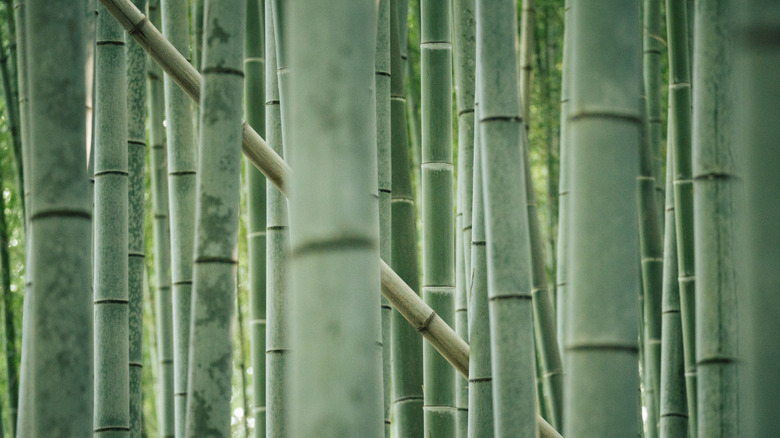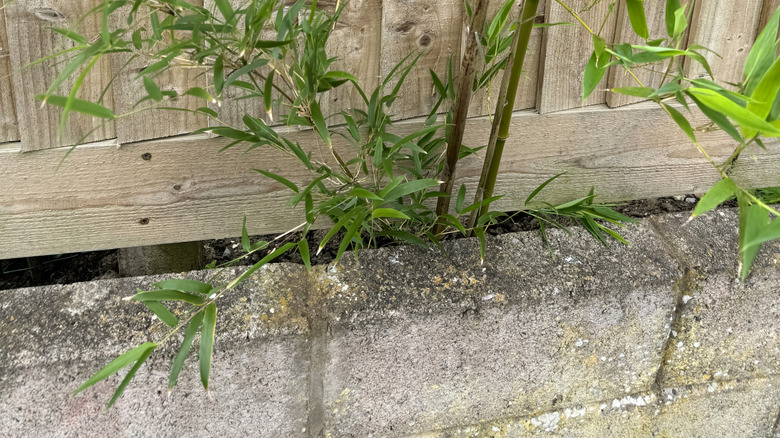Why You Should Never Plant This Bamboo Right Next To Your House
It's not hard to see why bamboo is such a popular choice for gardens. It's an interesting and exotic-looking plant that can add a lot to an outdoor aesthetic. But it turns out that certain species of this plant can also cause big problems, especially when planted near houses and other buildings.
Though bamboo is often thought to be a type of tree due to its woody stems, known as culms, it's actually part of the Poaceae, or grass family, which is made up of 789 genera and 11,783 species across 12 subfamilies. Specifically, bamboo sits in the subfamily Bambusoideae and comprises 1,400 species. In more simple terms, there are two types of bamboo you're most likely to encounter, especially in the U.S. Clumping bamboo typically refers to non-invasive species that grow in clusters. Running bamboo, on the other hand, is known to spread rapidly via rhizomes, or underground stems, and is often considered invasive for its ability to expand and cause major problems for other species and habitats.
That also means they can cause huge problems for your home, your neighbors' home, and everything that comes with it, from plumbing to foundations. As such, planting any type of running bamboo near your house or surrounding properties is basically a no go if you don't want to shell out thousands of dollars in repair costs and cause a significant headache for you and your neighbors.
Running bamboo is a fast-growing menace
Using bamboo on your property might seem like a great way to add some visual and exotic flair to your garden but planting running bamboo near your home is inadvisable at best. Due to the way in which it grows straight up and can reach impressive heights (one of the behavioral adaptations of the plant), running bamboo is often chosen by homeowners or even businesses to grow natural walls and barriers. The largest running bamboo species, timber bamboo, can reach heights of 70 feet and beyond, though most varieties will produce culms between 20 and 35 feet high, making them ideal for creating these natural barriers. But the running species can be difficult to keep under control due to the way in which they spread underground at a rapid pace.
Not only does running bamboo spread underground via their rhizomes, it also grows incredibly quickly. A 2020 study published in the Scientific World Journal notes that some species have been recorded growing at a rate of two inches per hour and reaching 60 feet in three months. A 2019 multi-university study notes that running bamboos can spread up to 15 feet a year and bamboo actually holds the Guinness World Record for the world's fastest growing plant, with one species recorded as growing at up to 35 inches, or almost 3 feet, per day, which equates to a speed of 0.00002 mph.
As such, while reports of bamboo being an unwieldy and invasive nightmare plant can be overblown, one thing you definitely don't want to do is plant any running bamboo near your home. These fast-moving underground rhizomes can easily spread underneath your house, causing major problems for the foundations, your floors, and even the plumbing. Once the rhizomes start sending up new culms, things can really get difficult.
Running bamboo has resulted in pricey disasters for homeowners
While there are ways to keep running bamboo contained, there have been nightmare reports of the plant overrunning peoples' homes. As The Guardian reported in 2024, over in the United Kingdom, bamboo species that were planted during the '90s and 2000s are starting to cause major problems for homeowners as the plants have spread and are now pushing their way through "paving stones, asphalt and even the foundations of houses." One homeowner even found themselves with bamboo culms shooting up from their skirting boards and through a wall before they were forced to remove the floorboards only to uncover an extensive web of rhizomes that had spread from a neighbor's garden and had been growing undetected for years. The cost to remove this sprawling network of running bamboo? £100,000, or $135,428 — and that's just one of many bamboo horror stories.
Unsurprisingly, then, a 2018 study published in the Journal for Nature Conservation determined that planting running bamboo species in general is inadvisable at best. The study investigated bamboo species in the wake of the plant being increasingly used as an alternative source of fiber for the production of various products, including paper and textiles. Researchers evaluated 18 running and 29 clumping bamboo species using a weed risk assessment tool and concluded that commercial use of bamboo should be restricted to clumping bamboo species in order to reduce the risk of the plant spreading and invading nearby natural areas, which can in turn contribute to animals becoming endangered. But that's also a good rule of thumb if you have a house and are considering planting some bamboo.
If you do find yourself with running bamboo that was planted before you bought a property, there are methods that can be used to maintain and limit the spread of the plant. Trenching involves digging a trench around the plant and clipping off new rhizomes when they emerge from the edge of the trench. Otherwise placing a barrier around the trench can be an effective way to stop the rhizomes spreading.


